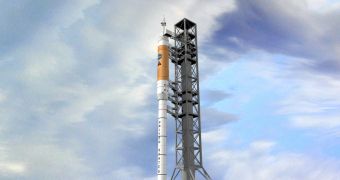The US space shuttles are supposed to retire in 2010 in order to give way to the Ares I rocket. However, it hasn't been a secret for awhile that NASA's new rocket design is fatally flawed and may shake itself to pieces during liftoff. NASA engineers believe they have found a solution to their problem, in the form of heavy-duty shock absorbers, as those used by pickup trucks.
Vibrations from the solid rocket boosters of the launcher wouldn't be a problem, in fact they are inevitable, albeit they exceed the specifications of the rocket. This basically means that if the solid boosters achieve a certain frequency, the whole rocket may begin to resonate and destroy itself and the Orion crew capsule that it will carry.
NASA team leader working on the problem, Garry Lyles, believes the simplest solution would be to use MacPherson struts, so that the weight of the top components of the spacecraft is taken by springs located in the lower end of the rocket. "These are actually absorbers that are used in vehicles today, especially one-ton and 1 ?-ton pickup trucks," said Lyles in a press conference held recently.
Alternatively, the computer models revealing the vibration problems of the Ares I rocket may not even be so severe, but engineers don't want to leave anything to chance.
In a federal report released last Thursday, federal auditors point out that the vibration issue is not the single problem faced by NASA. Both Constellation Program spacecraft, Ares I and Orion, suffer from weight problems, there are not enough testing facilities for the two and, to top it all, the contractor responsible for the Orion's heat shield apparently doesn't have the ability to replicate a manufacturing process developed and proved more than four decades ago.
The report has also revealed that NASA is routinely underfunded, even though the Constellation Program is expected to return a manned mission to the Moon by 2020. The federal auditor believes that, under the current circumstances, getting a man on the Moon by 2020 is an unrealistic goal.

 14 DAY TRIAL //
14 DAY TRIAL //